Effects of Different Land Use Types on Soil Surface Temperature in the Heihe River Basin
Abstract
1. Introduction
2. Data and Methods
2.1. Observation Sites and Data
2.2. Analysis Methodology
2.2.1. Soil Surface Heat Flux
2.2.2. Surface Energy Balance Equation
2.2.3. Aerodynamic Roughness Length
3. Results
3.1. Differences in the Micrometeorological Elements
3.2. Differences in Surface Energy Budget
3.2.1. Surface Radiation Energy
3.2.2. Land Surface Fluxes
3.3. Radiative and Non-Radiative Effects on the Differences of Surface Temperature
4. Discussion
5. Conclusions
Author Contributions
Funding
Data Availability Statement
Conflicts of Interest
References
- Sanderson, E.W.; Jaiteh, M.; Levy, M.A.; Redford, K.H.; Wannebo, A.V.; Woolmer, G. The human footprint and the last of the wild. Bioscience 2002, 52, 891–904. [Google Scholar] [CrossRef]
- Hassan, Z.; Shabbir, R.; Ahmad, S.S.; Malik, A.H.; Aziz, N.; Butt, A.; Erum, S. Dynamics of land use and land cover change (LULCC) using geospatial techniques: A case study of Islamabad Pakistan. Springerplus 2016, 5, 812. [Google Scholar] [CrossRef] [PubMed]
- Peng, S.S.; Piao, S.; Zeng, Z.; Ciais, P.; Zhou, L.; Li, L.Z.X.; Myneni, R.B.; Yin, Y.; Zeng, H. Afforestation in china cools local land surface temperature. Proc. Natl. Acad. Sci. USA 2014, 111, 2915–2919. [Google Scholar] [CrossRef] [PubMed]
- Vitousek, P.M.; Mooney, H.A.; Lubchenco, J.; Melillo, J.M. Human domination of earth’s ecosystems. Science 1997, 277, 494–499. [Google Scholar] [CrossRef]
- Feddema, J.J.; Oleson, K.W.; Bonan, G.B.; Mearns, L.O.; Buja, L.E.; Meehl, G.A.; Washington, W.M. The Importance of land-cover change in simulating future climates. Science 2005, 310, 1674–1678. [Google Scholar] [CrossRef]
- Foley, J.A.; DeFries, R.; Asner, G.P.; Barford, C.; Bonan, G.; Carpenter, S.R.; Chapin, F.S.; Coe, M.T.; Daily, G.C.; Gibbs, H.K.; et al. Global consequences of land use. Science 2005, 309, 570–574. [Google Scholar] [CrossRef]
- Pongratz, J.; Reick, C.H.; Raddatz, T.; Claussen, M. Biogeophysical versus biogeochemical climate response to historical anthropogenic land cover change. Geophys. Res. Lett. 2010, 37, L08702. [Google Scholar] [CrossRef]
- Baldocchi, D. Managing land and climate. Nat. Clim. Change 2014, 4, 330–331. [Google Scholar] [CrossRef]
- Cao, Q.; Yu, D.; Georgescu, M.; Han, Z.; Wu, J. Impacts of land use and land cover change on regional climate: A case study in the agro-pastoral transitional zone of China. Environ. Res. Lett. 2015, 10, 124025. [Google Scholar] [CrossRef]
- Alkama, R.; Cescatti, A. Biophysical climate impacts of recent changes in global forest cover. Science 2016, 351, 600–604. [Google Scholar] [CrossRef]
- Lee, X.; Goulden, M.L.; Hollinger, D.Y.; Barr, A.; Black, T.A.; Bohrer, G.; Bracho, R.; Drake, B.; Goldstein, A.; Gu, L.; et al. Observed increase in local cooling effect of deforestation at higher latitudes. Nature 2011, 479, 384–387. [Google Scholar] [CrossRef]
- Li, Y.; Zhao, M.; Motesharrei, S.; Mu, Q.; Kalnay, E.; Li, S. Local cooling and warming effects of forests based on satellite observations. Nat. Commun. 2015, 6, 6603. [Google Scholar] [CrossRef]
- Arora, V.K.; Montenegro, A. Small temperature benefits provided by realistic afforestation efforts. Nat. Geosci. 2011, 4, 514–518. [Google Scholar] [CrossRef]
- Georgescu, M.; Lobell, D.B.; Field, C.B. Direct climate effects of perennial bioenergy crops in the United States. Proc. Natl. Acad. Sci. USA 2011, 108, 4307–4312. [Google Scholar] [CrossRef]
- Loarie, S.R.; Lobell, D.; Asner, G.; Mu, Q.; Field, C.B. Direct impacts on local climate of sugar-cane expansion in Brazil. Nat. Clim. Change 2011, 1, 105–109. [Google Scholar] [CrossRef]
- He, Y.; D’Odorico, P.; De Wekker, S.F.J.; Fuentes, J.D.; Litvak, M. On the impact of shrub encroachment on microclimate conditions in the northern Chihuahuan desert. J. Geophys. Res. 2010, 115, D21120. [Google Scholar] [CrossRef]
- Bonan, G.B. Observational evidence for reduction of daily maximum temperature by croplands in the midwest United States. J. Climate 2001, 14, 2430–2442. [Google Scholar] [CrossRef]
- Bonan, G.B.; Pollard, D.; Thompson, S.L. Effects of boreal forest vegetation on global climate. Nature 1992, 359, 716–718. [Google Scholar] [CrossRef]
- Claussen, M.; Brovkin, V.; Ganopolski, A. Biogeophysical versus biogeochemical feedbacks of large-scale land cover change. Geophys. Res. Lett. 2001, 28, 1011–1014. [Google Scholar] [CrossRef]
- Davin, E.L.; de Noblet-Ducoudré, N. Climatic impact of global-scale deforestation: Radiative versus nonradiative processes. J. Climate 2010, 23, 97–112. [Google Scholar] [CrossRef]
- Bounoua, L.; DeFries, R.; Collatz, G.J.; Sellers, P.; Khan, H. Effects of land cover conversion on surface climate. Clim. Change 2002, 52, 29–64. [Google Scholar] [CrossRef]
- Defries, R.S.; Bounoua, L.; Collatz, G.J. Human modification of the landscape and surface climate in the next fifty years. Glob. Chang. Biol. 2002, 8, 438–458. [Google Scholar] [CrossRef]
- Kanda, M.; Kanega, M.; Kawai, T.; Moriwaki, R.; Sugawara, H. Roughness lengths for momentum and heat derived from outdoor urban scale models. J. Appl. Meteorol. Climatol. 2007, 46, 1067–1079. [Google Scholar] [CrossRef]
- Campra, P.; Garcia, M.; Canton, Y.; Orueta, A.P. Surface temperature cooling trends and negative radiative forcing due to land use change toward greenhouse farming in southeastern Spain. J. Geophys. Res.-Atmos. 2008, 113, D18109. [Google Scholar] [CrossRef]
- Baldocchi, D.; Ma, S. How will land use affect air temperature in the surface boundary layer? Lessons learned from a comparative study on the energy balance of an oak savanna and annual grassland in California, USA. Tellus. B 2013, 65, 19994. [Google Scholar] [CrossRef]
- Yang, K.; Wu, H.; Qin, J.; Lin, C.; Tang, W.; Chen, Y. Recent climate changes over the Tibetan Plateau and their impacts on energy and water cycle: A review. Glob. Planet Change 2014, 112, 79–91. [Google Scholar] [CrossRef]
- Wang, L.; Lee, X.; Schultz, N.; Chen, S.; Wei, Z.; Fu, C.; Gao, Y.; Yang, Y.; Lin, G. Response of surface temperature to afforestation in the Kubuqi Desert, Inner Mongolia. J. Geophys. Res.-Atmos. 2018, 123, 948–964. [Google Scholar] [CrossRef]
- Ge, J.; Guo, W.; Pitman, A.J.; De Kauwe, M.G.; Chen, X.; Fu, C. The nonradiative effect dominates local surface temperature change caused by afforestation in China. J. Climate. 2019, 32, 4445–4471. [Google Scholar] [CrossRef]
- Hirsch, A.L.; Pitman, A.J.; Kala, J. The role of land cover change in modulating the soil moisture-temperature land-atmosphere coupling strength over Australia. Geophys. Res. Lett. 2014, 41, 5883–5890. [Google Scholar] [CrossRef]
- Benson-Lira, V.; Georgescu, M.; Kaplan, S.; Vivoni, E.R. Loss of a lake system in a megacity: The impact of urban expansion on seasonal meteorology in Mexico City. J. Geophys. Res.-Atmos. 2016, 121, 3079–3099. [Google Scholar] [CrossRef]
- Houghton, R.A.; House, J.I.; Pongratz, J.; Van Der Werf, G.R.; DeFries, R.S.; Hansen, M.C.; Le Quéré, C.; Ramankutty, N. Carbon emissions from land use and land-cover change. Biogeosciences 2012, 9, 5125–5142. [Google Scholar] [CrossRef]
- Guo, W.; Wang, X.; Sun, J.; Ding, A.; Zou, J. Comparison of land–atmosphere interaction at different surface types in the mid to lower reaches of the Yangtze River valley. Atmos. Chem. Phys. 2016, 16, 9875–9890. [Google Scholar] [CrossRef]
- Wang, X.; Guo, W.; Qiu, B.; Liu, Y.; Sun, J.; Ding, A. Quantifying the contribution of land use change to surface temperature in the lower reaches of the Yangtze River. Atmos. Chem. Phys. 2017, 17, 4989–4996. [Google Scholar] [CrossRef]
- Huang, J.; Zhang, W.; Zuo, J.; Bi, J.; Shi, J.; Wang, X.; Chang, Z.; Huang, Z.; Yang, S.; Zhang, B.; et al. An overview of the semi-arid climate and environment research observatory over the Loess Plateau. Adv. Atmos. Sci. 2008, 25, 906–921. [Google Scholar] [CrossRef]
- Wang, G.; Huang, J.; Guo, W.; Zuo, J.; Wang, J.; Bi, J.; Huang, Z.; Shi, J. Observation analysis of land-atmosphere interactions over the Loess Plateau of northwest China. J. Geophys. Res.-Atmos. 2010, 115, D00K17. [Google Scholar] [CrossRef]
- Hari, P.; Petäjä, T.; Bäck, J.; Kerminen, V.-M.; Lappalainen, H.K.; Vihma, T.; Laurila, T.; Viisanen, Y.; Vesala, T.; Kulmala, M. Conceptual design of a measurement network of the global change. Atmos. Chem. Phys. 2016, 16, 1017–1028. [Google Scholar] [CrossRef]
- Niu, G.-Y.; Yang, Z.-L.; Mitchell, K.E.; Chen, F.; Ek, M.B.; Barlage, M.; Kumar, A.; Manning, K.; Niyogi, D.; Rosero, E.; et al. The community Noah land surface model with multiparameterization options (Noah-MP): 1. Model description and evaluation with local-scale measurements. J. Geophys. Res.-Atmos. 2011, 116, D12109. [Google Scholar] [CrossRef]
- Huang, J.; Yu, H.; Guan, X.; Wang, G.; Guo, R. Accelerated dryland expansion under climate change. Nat. Clim. Change 2015, 6, 166–171. [Google Scholar] [CrossRef]
- Zhang, X.; Xiong, Z.; Zhang, X.; Shi, Y.; Liu, J.; Shao, Q.; Yan, X. Using multi-model ensembles to improve the simulated effects of land use/cover change on temperature: A case study over northeast China. Clim. Dynam. 2016, 46, 765–778. [Google Scholar] [CrossRef]
- Fu, Q.; Johanson, C.M.; Wallace, J.M.; Reichler, T. Enhanced mid-latitude tropospheric warming in satellite measurements. Science 2006, 312, 1179. [Google Scholar] [CrossRef]
- Ma, Z.; Fu, C. Some evidences of drying trend over North China from 1951 to 2004. Chinese Sci. Bull. 2006, 51, 2913–2925. [Google Scholar] [CrossRef]
- Jiang, B.; Liang, S. Improved vegetation greenness increases summer atmospheric water vapor over Northern China. J. Geophys. Res.-Atmos. 2013, 118, 8129–8139. [Google Scholar] [CrossRef]
- Liang, J.N.; Zhang, L.; Wang, Y.; Cao, X.J.; Zhang, Q.; Wang, H.B.; Zhang, B.D. Turbulence regimes and the validity of similarity theory in the stable boundary layer over complex terrain of the Loess Plateau, China. J. Geophys. Res.-Atmos. 2014, 119, 6009–6021. [Google Scholar] [CrossRef]
- Li, X.; Cheng, G.; Liu, S.; Xiao, Q.; Ma, G.; Jin, R.; Che, T.; Liu, Q.; Wang, W.; Qi, Y.; et al. Heihe watershed allied telemetry experimental research (HiWATER): Scientific objectives and experimental design. Bull. Amer. Meteorol. Soc. 2013, 94, 1145–1160. [Google Scholar] [CrossRef]
- Xu, Z.; Liu, S.; Li, X.; Shi, S.; Wang, J.; Zhu, Z.; Xu, T.; Wang, W.; Ma, M. Intercomparison of surface energy flux measurement systems used during the HiWATER-MUSOEXE. J. Geophys. Res.-Atmos. 2013, 118, 13140–13157. [Google Scholar] [CrossRef]
- Liu, Y.; Guo, W.D.; Song, Y.M. Estimation of key surface parameters in semi-arid region and their impacts on improvement of surface fluxes simulation. Sci. China Earth Sci. 2016, 59, 307–319. [Google Scholar] [CrossRef]
- Heusinkveld, B.G.; Jacobs, A.F.G.; Holtslag, A.A.M.; Berkowicz, S.M. Surface energy balance closure in an arid region: Role of soil heat flux. Agric. For. Meteorol. 2004, 122, 21–37. [Google Scholar] [CrossRef]
- Ochsner, T.E.; Sauer, T.J.; Horton, R. Soil heat storage measurements in energy balance studies. Agron. J. 2007, 99, 311–319. [Google Scholar] [CrossRef]
- Burba, G.G.; Verma, S.B.; Kim, J. Energy fluxes of an open water area in a mid-latitude prairie wetland. Bound. Lay. Meteorol. 1999, 91, 495–504. [Google Scholar] [CrossRef]
- Ma, Y.; Menenti, M.; Feddes, R.; Wang, J. Analysis of the land surface heterogeneity and its impact on atmospheric variables and the aerodynamic and thermodynamic roughness lengths. J. Geophys. Res.-Atmos. 2008, 113, D08113. [Google Scholar] [CrossRef]
- Liu, S.; Xu, Z.; Song, L.; Zhao, Q.; Ge, Y.; Xu, T.; Ma, Y.; Zhu, Z.; Jia, Z.; Zhang, F. Upscaling evapotranspiration measurements from multi-site to the satellite pixel scale over heterogeneous land surfaces. Agric. For. Meteorol. 2016, 230-231, 97–113. [Google Scholar] [CrossRef]
- He, Y.; De Wekker, S.F.J.; Fuentes, J.D.; D’Odorico, P. Coupled land-atmosphere modeling of the effects of shrub encroachment on nighttime temperatures. Agric. For. Meteorol. 2011, 151, 1690–1697. [Google Scholar] [CrossRef]
- Kang, S.L.; Davis, K.J.; LeMone, M.A. Observations of the ABL structures over a heterogeneous land surface during IHOP_2002. J. Hydrometeorol. 2007, 8, 221–244. [Google Scholar] [CrossRef]
- LeMone, M.A.; Tewari, M.; Chen, F.; Alferi, J.G.; Niyogi, D. Evaluation of the Noah land surface model using data from a fair weather IHOP_2002 day with heterogeneous surface fluxes. Mon. Weather Rev. 2008, 136, 4915–4941. [Google Scholar] [CrossRef]
- Yuan, G.; Zhang, L.; Liang, J.; Cao, X.; Guo, Q.; Yang, Z. Impacts of initial soil moisture and vegetation on the diurnal temperature range in arid and semiarid regions in China. J. Geophys. Res.-Atmos. 2017, 122, 11568–11583. [Google Scholar] [CrossRef]
- Schultz, N.M.; Lawrence, P.J.; Lee, X. Global satellite data highlights the diurnal asymmetry of the surface temperature response to deforestation. J. Geophys. Res.-Biogeo. 2017, 122, 903–917. [Google Scholar] [CrossRef]
- Luyssaert, S.; Jammet, M.; Stoy, P.C.; Estel, S.; Pongratz, J.; Ceschia, E.; Churkina, G.; Don, A.; Erb, K.; Ferlicoq, M.; et al. Land management and land cover change have impacts of similar magnitude on surface temperature. Nat. Clim. Chang. 2014, 4, 389–393. [Google Scholar] [CrossRef]
- Meier, R.; Davin, E.L.; Lejeune, Q.; Hauser, M.; Li, Y.; Martens, B.; Schultz, N.M.; Sterling, S.; Thiery, W. Evaluating and improving the Community Land Model’s sensitivity to land cover. Biogeosciences 2018, 15, 4731–4757. [Google Scholar] [CrossRef]
- Winckler, J.; Reick, C.H.; Luyssaert, S.; Cescatti, A.; Stoy, P.C.; Lejeune, Q.; Raddatz, T.; Chlond, A.; Heidkamp, M.; Pongratz, J. Different response of surface temperature and air temperature to deforestation in climate models. Earth Syst. Dynam. 2019, 10, 473–484. [Google Scholar] [CrossRef]
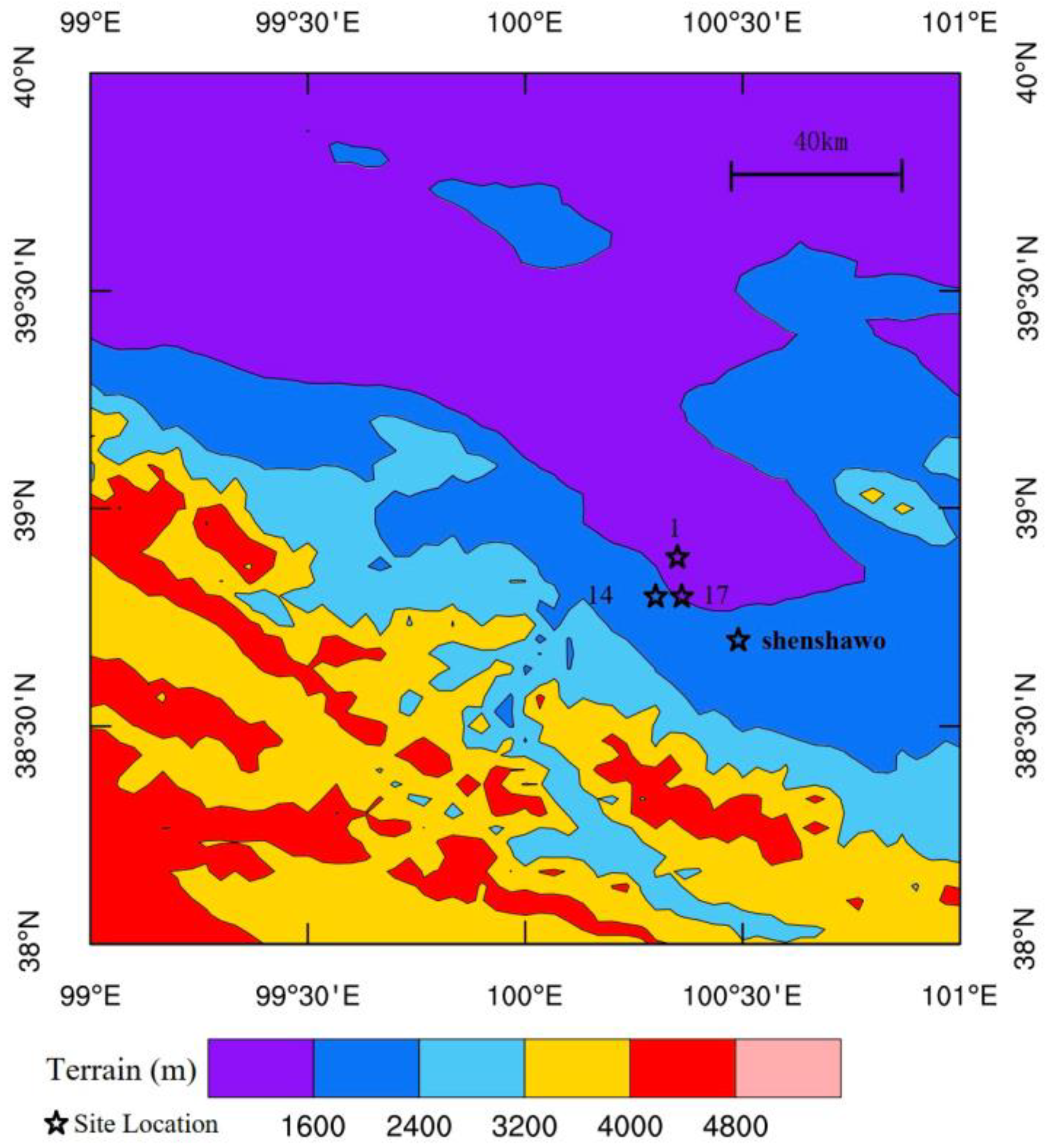
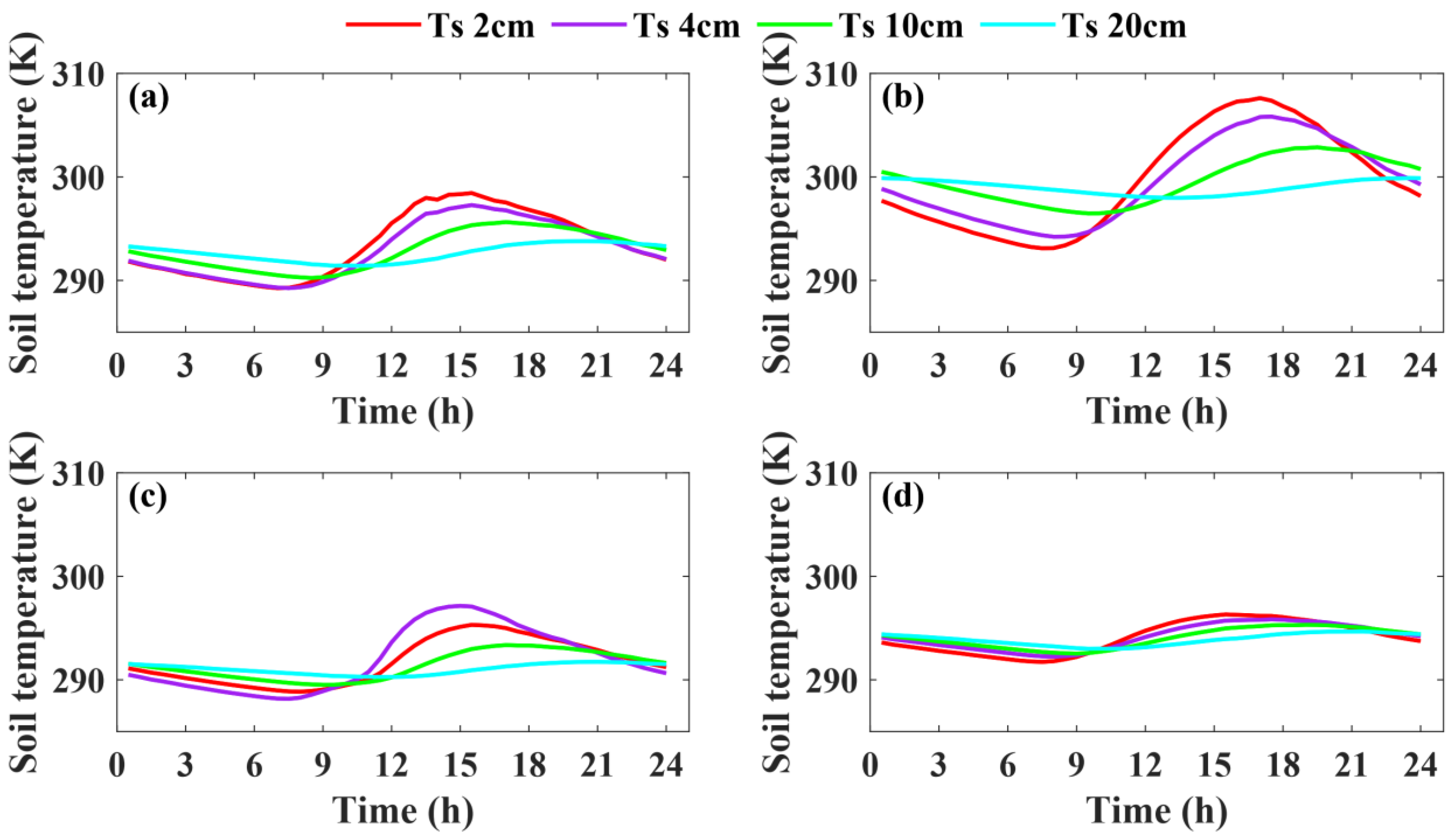
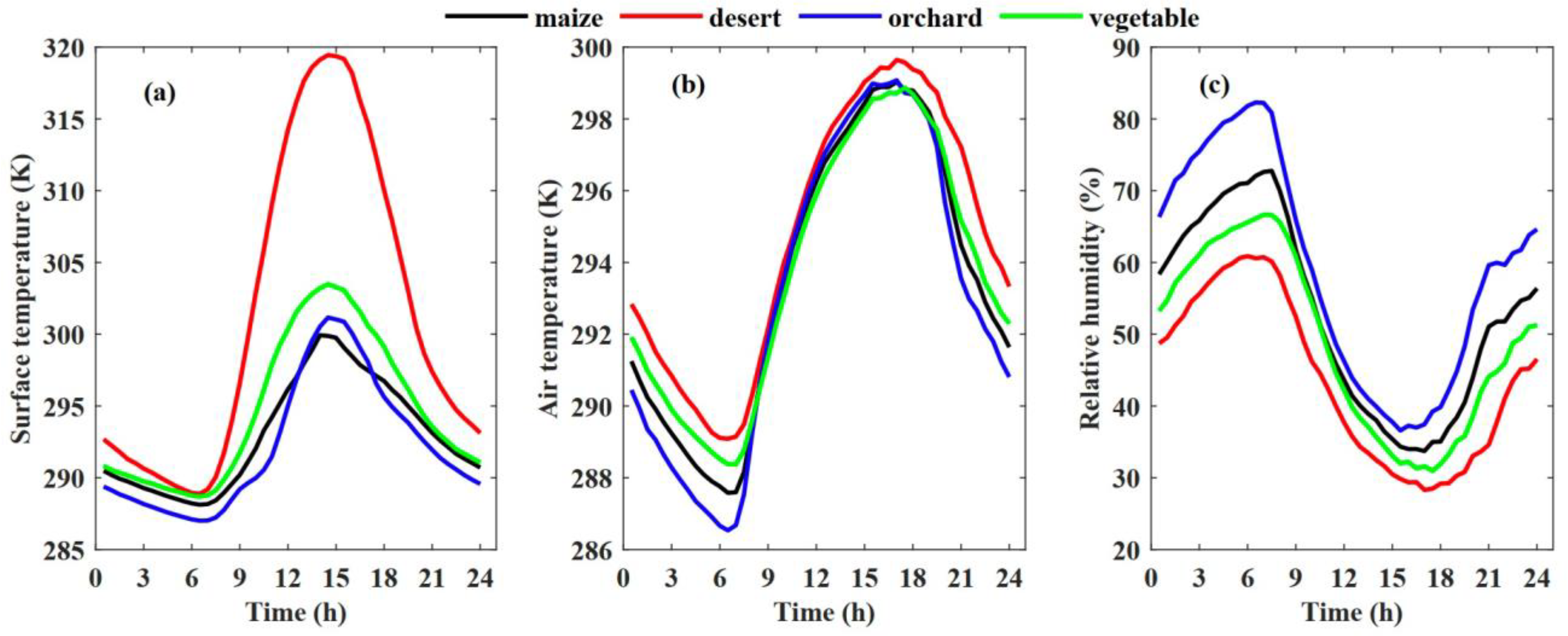
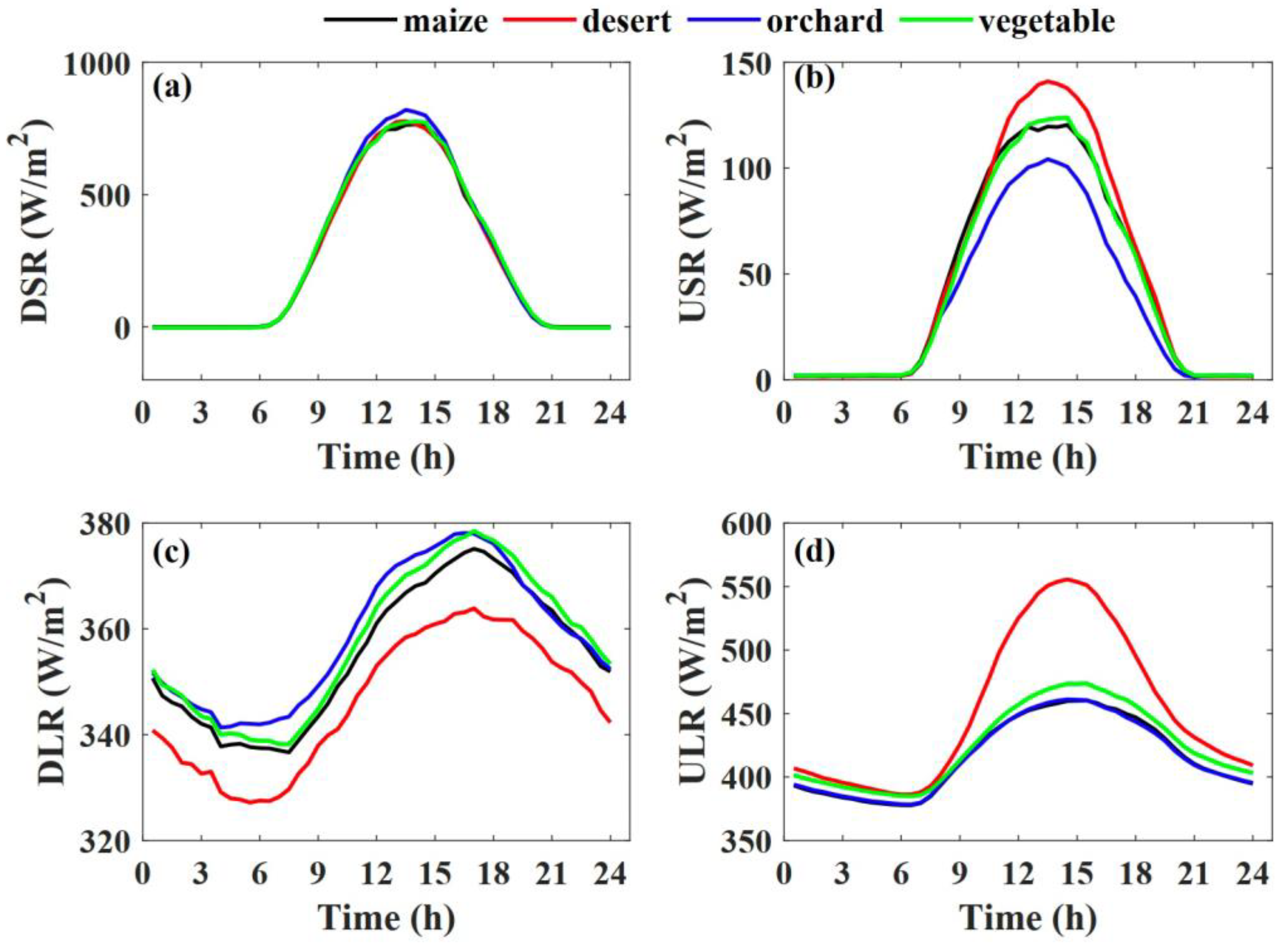
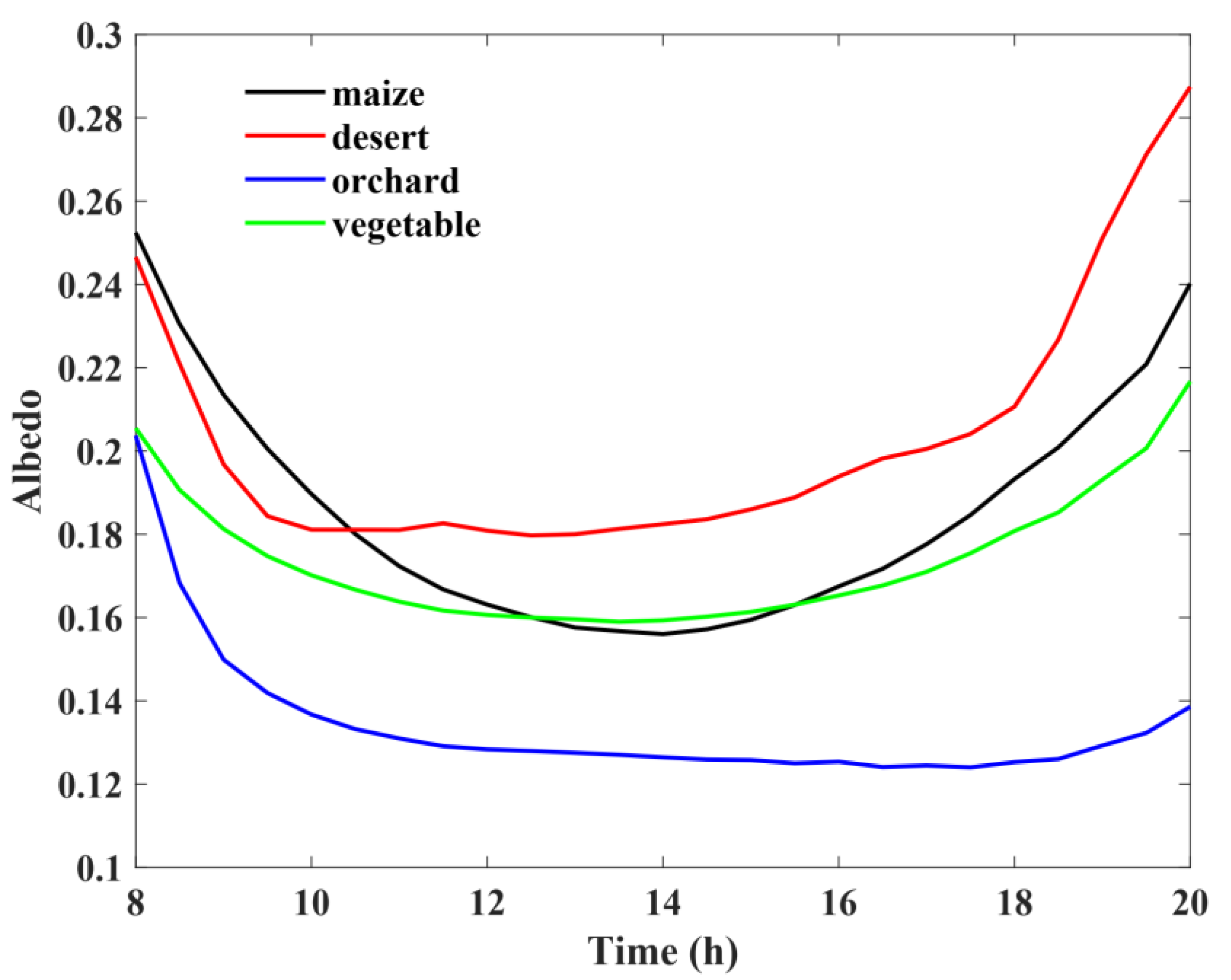
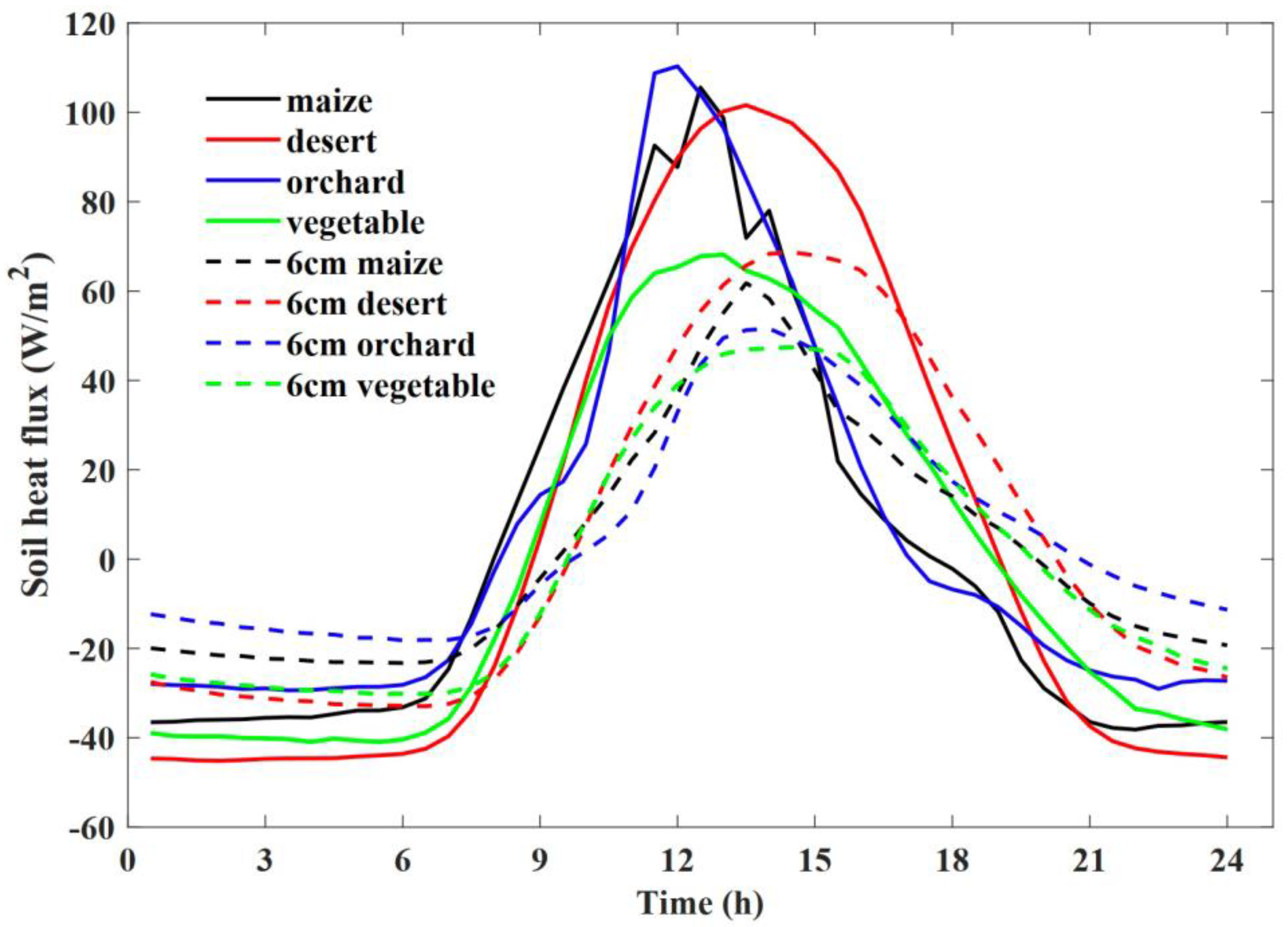
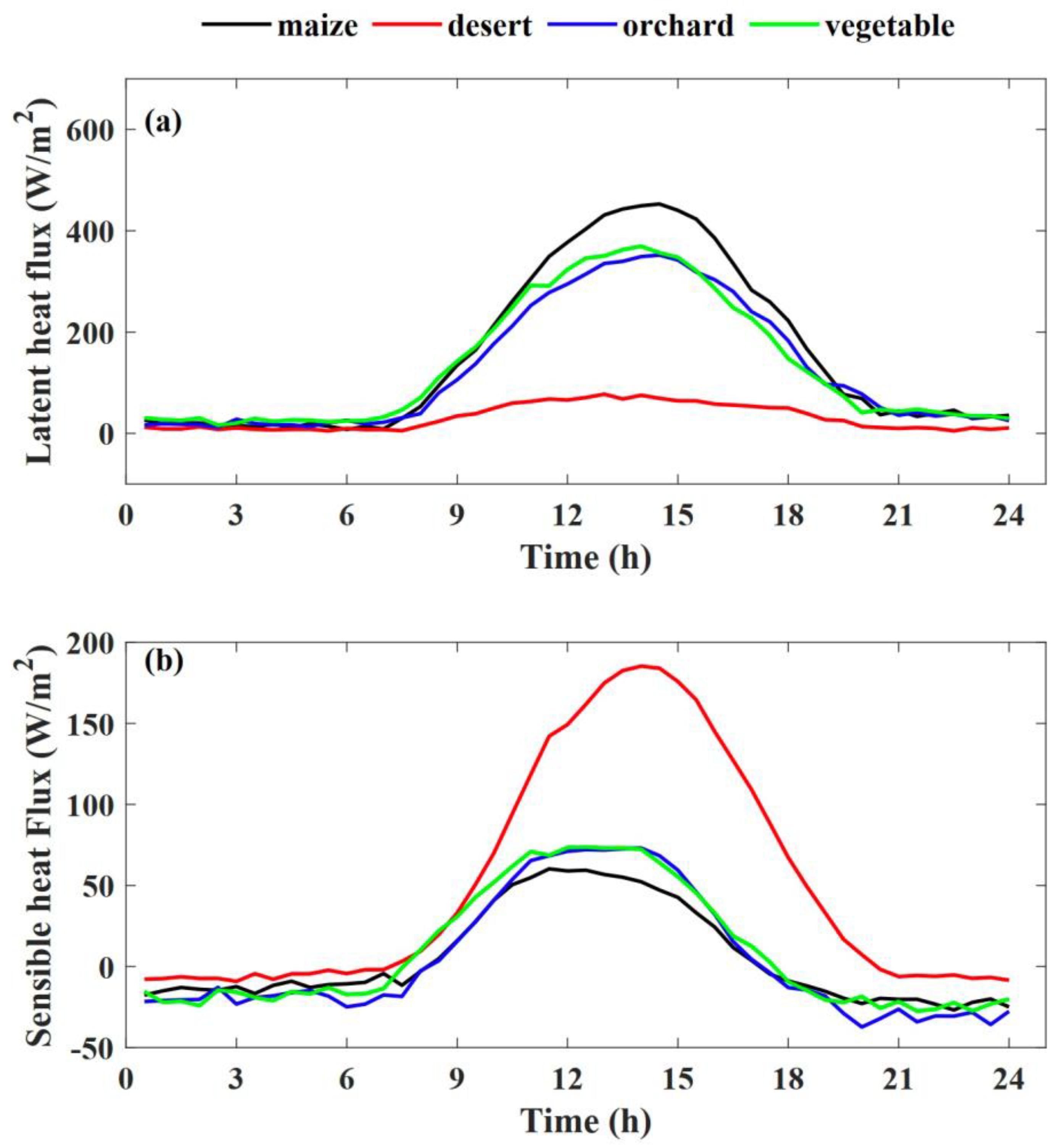
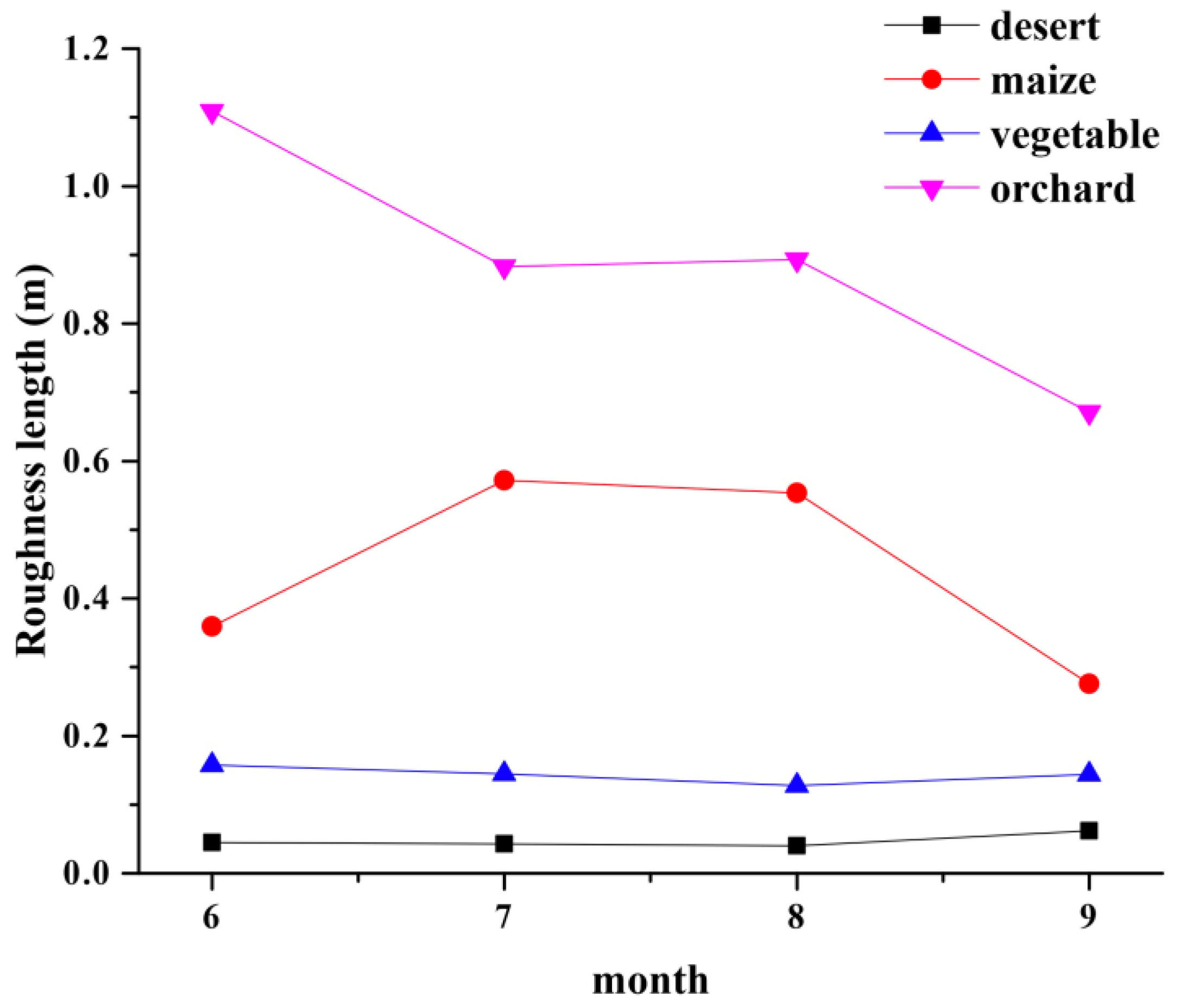
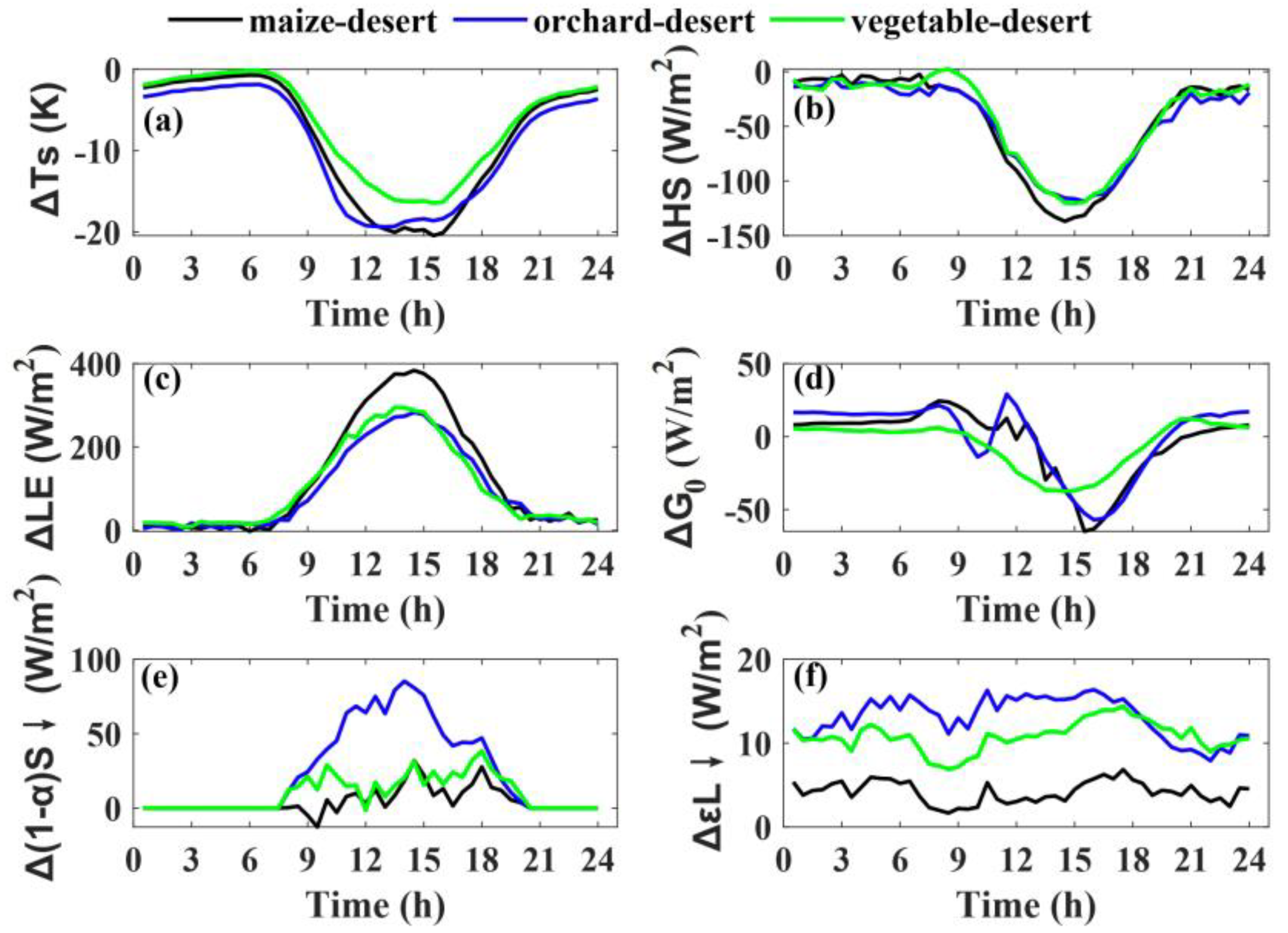
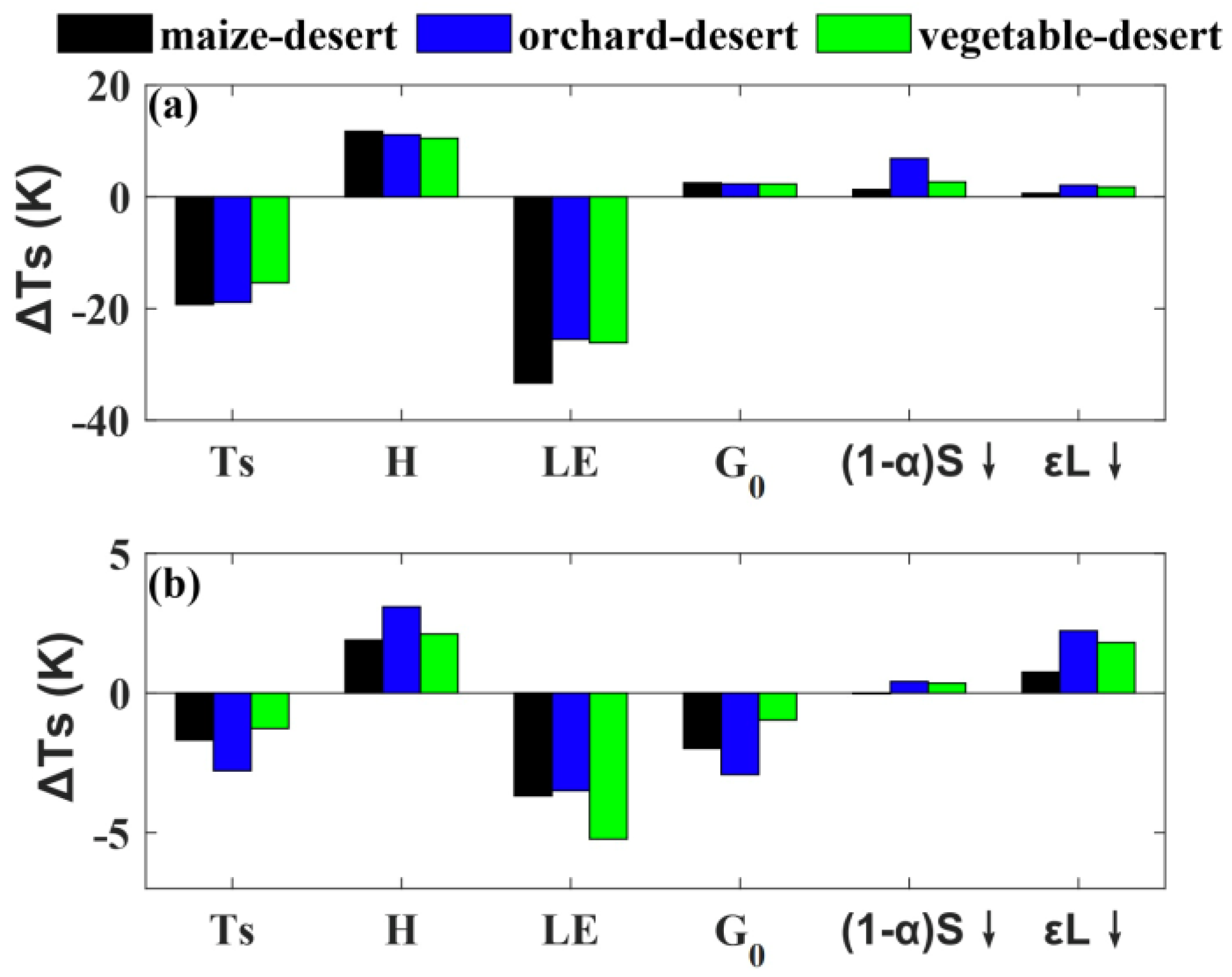
| Observation Items | Type, Manufacturers | Height (m) | Site |
|---|---|---|---|
| Wind speed/direction | 03002, RM Young, USA | 10 | 1 |
| 03001, RM Young, USA | 5/10 | Shenshawo | |
| 034B, Met One, USA | 10 | 14, 17 | |
| Air temperature and humidity | HMP155, Vaisala, Finland | 5 | 1 |
| HMP45D, Vaisala, Finland | 5 | 14 | |
| HMP45C, Vaisala, Finland | 5 | 17 | |
| HMP45AC, Vaisala, Finland | 5/10 | Shenshawo | |
| Radiation | CNR4, Kipp&Zonen, Netherland | 6 | 1, 14 |
| CNR1, Kipp&Zonen, Netherland | 6 | 17, Shenshawo | |
| Soil temperature | 109ss-L, Campbell, USA | 0, −0.02, −0.04, −0.1, −0.2, −0.4, −0.6, −1 | 1 |
| AV-10T, Avalon, USA | 14 | ||
| 109, Campbell, USA | 17, Shenshawo | ||
| Soil moisture | SM300, Delta-T Devices, UK | −0.02, −0.04, −0.1, −0.2, −0.4, −0.6, −1 | 1 |
| ECH2O-5, Decagon Devices, USA | 14 | ||
| CS616, Campbell, USA | 17, Shenshawo | ||
| Soil heat flux | HFP01, Hukseflux, Netherland | −0.06 | 1, 17, Shenshawo |
| HFT3, Campbell, USA | 14 | ||
| Sensible heat flux, latent heat flux | CSAT3 and Li7500, Campbell/Li-cor, USA | 4.6 | 14, Shenshawo |
| CSAT3 and EC150, Campbell, USA | 7 | 17 | |
| Gill and Li7500A, Gill, UK; Li-cor, USA | 3.8 | 1 |
Disclaimer/Publisher’s Note: The statements, opinions and data contained in all publications are solely those of the individual author(s) and contributor(s) and not of MDPI and/or the editor(s). MDPI and/or the editor(s) disclaim responsibility for any injury to people or property resulting from any ideas, methods, instructions or products referred to in the content. |
© 2023 by the authors. Licensee MDPI, Basel, Switzerland. This article is an open access article distributed under the terms and conditions of the Creative Commons Attribution (CC BY) license (https://creativecommons.org/licenses/by/4.0/).
Share and Cite
Yuan, G.; Zhang, Y.; Li, E.; Liu, Y. Effects of Different Land Use Types on Soil Surface Temperature in the Heihe River Basin. Sustainability 2023, 15, 3859. https://doi.org/10.3390/su15043859
Yuan G, Zhang Y, Li E, Liu Y. Effects of Different Land Use Types on Soil Surface Temperature in the Heihe River Basin. Sustainability. 2023; 15(4):3859. https://doi.org/10.3390/su15043859
Chicago/Turabian StyleYuan, Guanghui, Yu Zhang, Erchen Li, and Yubao Liu. 2023. "Effects of Different Land Use Types on Soil Surface Temperature in the Heihe River Basin" Sustainability 15, no. 4: 3859. https://doi.org/10.3390/su15043859
APA StyleYuan, G., Zhang, Y., Li, E., & Liu, Y. (2023). Effects of Different Land Use Types on Soil Surface Temperature in the Heihe River Basin. Sustainability, 15(4), 3859. https://doi.org/10.3390/su15043859










